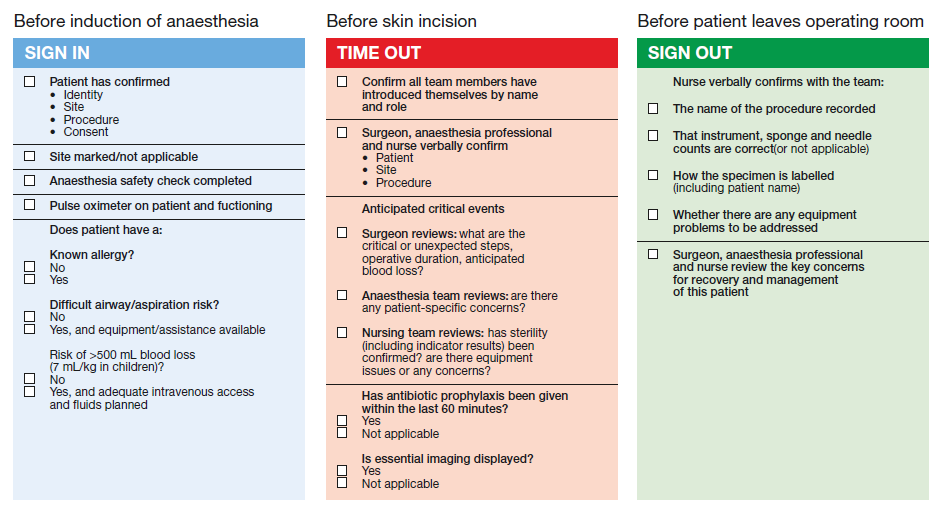Makindo Medical Notes"One small step for man, one large step for Makindo" |
|
|---|---|
| Download all this content in the Apps now Android App and Apple iPhone/Pad App | |
| MEDICAL DISCLAIMER: The contents are under continuing development and improvements and despite all efforts may contain errors of omission or fact. This is not to be used for the assessment, diagnosis, or management of patients. It should not be regarded as medical advice by healthcare workers or laypeople. It is for educational purposes only. Please adhere to your local protocols. Use the BNF for drug information. If you are unwell please seek urgent healthcare advice. If you do not accept this then please do not use the website. Makindo Ltd. |
Safety Surgical checklist WHO
-
| About | Anaesthetics and Critical Care | Anatomy | Biochemistry | Cardiology | Clinical Cases | CompSci | Crib | Dermatology | Differentials | Drugs | ENT | Electrocardiogram | Embryology | Emergency Medicine | Endocrinology | Ethics | Foundation Doctors | Gastroenterology | General Information | General Practice | Genetics | Geriatric Medicine | Guidelines | Haematology | Hepatology | Immunology | Infectious Diseases | Infographic | Investigations | Lists | Microbiology | Miscellaneous | Nephrology | Neuroanatomy | Neurology | Nutrition | OSCE | Obstetrics Gynaecology | Oncology | Ophthalmology | Oral Medicine and Dentistry | Paediatrics | Palliative | Pathology | Pharmacology | Physiology | Procedures | Psychiatry | Radiology | Respiratory | Resuscitation | Rheumatology | Statistics and Research | Stroke | Surgery | Toxicology | Trauma and Orthopaedics | Twitter | Urology
Related Subjects:
|Swiss Cheese Model of Patient Harm
|Safety Surgical checklist WHO
The WHO Surgical Safety Checklist is a structured patient safety tool designed to reduce avoidable surgical harm.
It was launched in 2008 under the "Safe Surgery Saves Lives" initiative and has since become mandatory in many healthcare systems (including the NHS).
Surgery saves lives but carries significant risks — WHO estimated that 234 million operations are performed annually worldwide, with complication rates of up to 25% in some settings.
Errors such as wrong-site surgery, retained instruments, and unrecognised bleeding can be prevented by structured communication and checks.
The checklist creates “pause points” where the surgical team reviews critical safety steps together.
The checklist is divided into three phases, corresponding to natural pauses in the surgical process:
The WHO Surgical Safety Checklist is a simple but powerful intervention that transforms operating theatres into safer systems.
By embedding structured communication and safety checks, it reduces complications, saves lives, and improves teamwork.
Its success depends not just on the checklist itself, but on fostering a culture of safety and openness where every team member has a voice.
🩺 Introduction

📚 Background and Rationale
🗂️ Structure of the Checklist
📊 Implementation and Impact
⚠️ Challenges and Future Directions
🚨 Quick Reference: WHO Surgical Safety Checklist
✅ Conclusion
📚 References